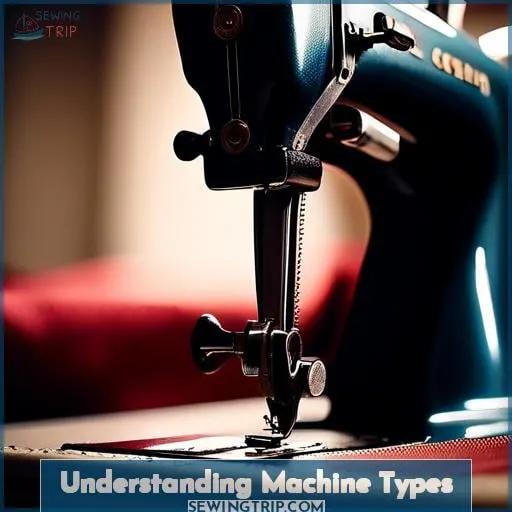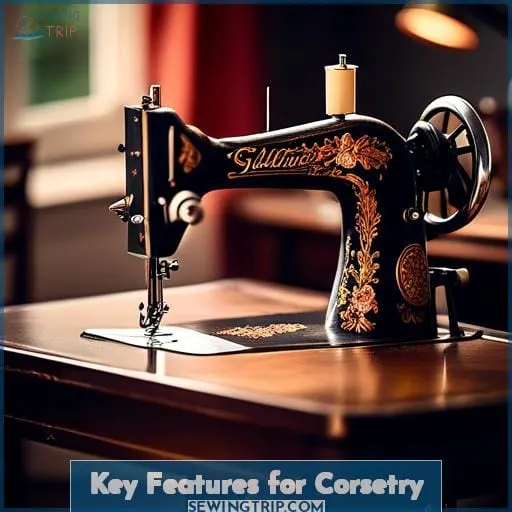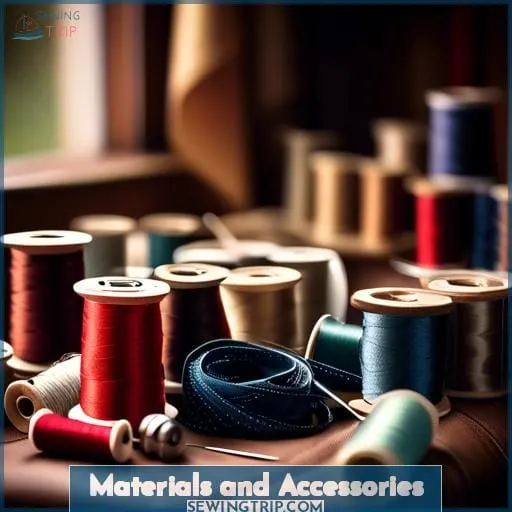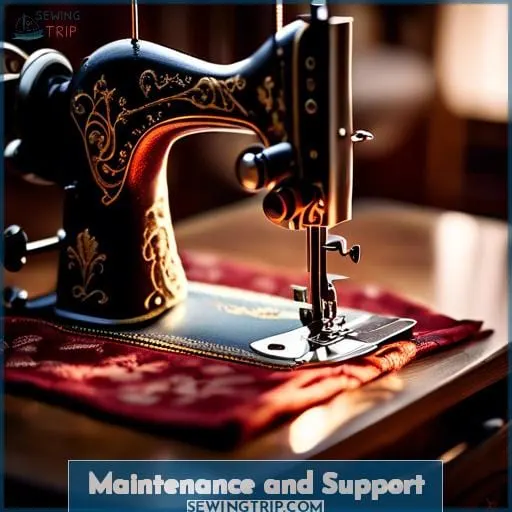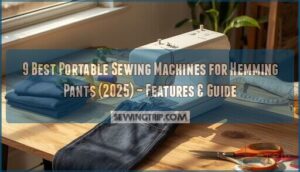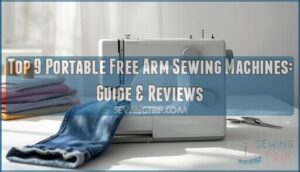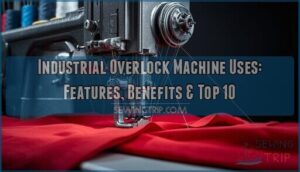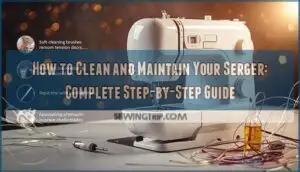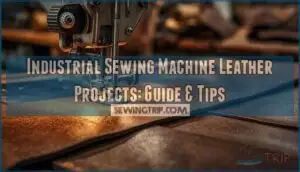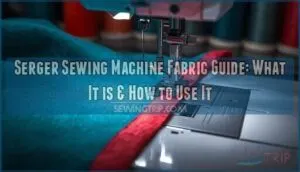This site is supported by our readers. We may earn a commission, at no cost to you, if you purchase through links.
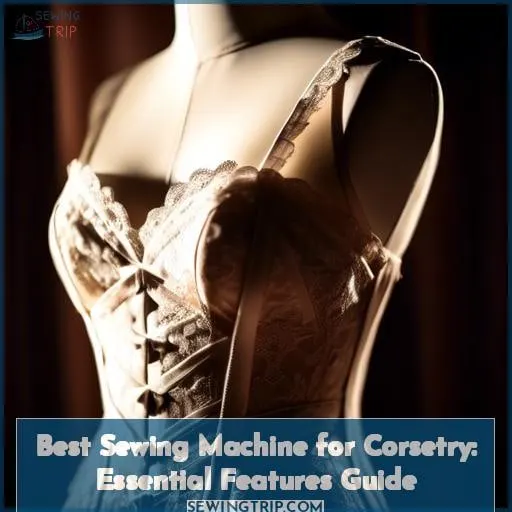 Crafting corsets demands a machine that’s as resilient and precise as your vision for the perfect fit. You’ll need a workhorse that can handle layers of tough coutil and delicate silks with equal finesse.
Crafting corsets demands a machine that’s as resilient and precise as your vision for the perfect fit. You’ll need a workhorse that can handle layers of tough coutil and delicate silks with equal finesse.
The best sewing machine for corsetry isn’t just any model off the shelf; it’s a robust ally, ready to endure the rigors of tight stitches and the demands of heavy fabric.
Let’s dive into the essential features that will empower your corset-making journey.
Table Of Contents
Key Takeaways
- Prioritize sewing machines that are sturdy, preferably made of metal, and not classified as beginner machines, as corsetry requires handling multiple layers of thick materials like coutil.
- Consider mid-range to high-end machines, as anything below mid-range may not be suitable for the demands of corset making. Brands like Janome, Singer, and Bernina are recommended for their durability and ability to handle heavy-duty sewing.
- Avoid entry-level domestic machines from brands like Brother for corsetry, as they often struggle with tension issues and cannot keep pace with the thick layers involved in corset making.
- Look for machines that offer a straight stitch option for professional-quality corsetry, but also have a backup domestic machine for decorative stitches or zigzag stitches if needed. Vintage machines like the Singer 201K are praised for their industrial quality on a budget.
Selecting the Right Machine
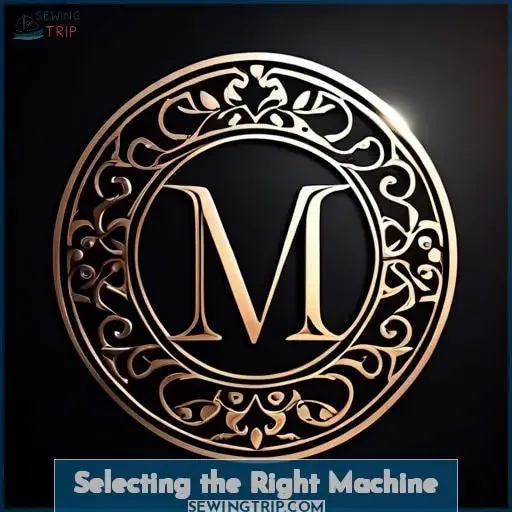
When choosing the best sewing machine for corsetry, you’ll need to consider your specific sewing needs and the fabrics you plan to use.
Take the time to compare different brands and models, focusing on features like automatic tension adjustment and the ability to sew through multiple layers.
It’s essential to select a machine that offers both the durability and precision required for creating high-quality corsets.
Assessing Sewing Needs
One must carefully evaluate their sewing requirements before selecting a machine. The machine should not only handle the robust needs of corsetry but also match their skill level and intended use.
Assessing preferences and exploring techniques early on can save you from the frustration of understanding limitations later.
Identifying challenges specific to corset making, like sewing through many layers of sturdy fabric or inserting steel boning, is crucial.
Customizing solutions with a sewing machine that offers reinforced seams and can handle the rigors of corsetry will empower you to master this art form.
Comparing Brands and Models
Having assessed your sewing needs, you’re now ready to compare brands and models to find the best sewing machine for corset making. You’ll want to focus on machines that can handle the multiple layers and sturdy materials typically used in corsets.
Consider the durability of the machine, its ability to create precise stitches, and the availability of specialized attachments for boning channels. Researching user reviews and manufacturer specifications can help you make an informed decision.
Understanding Machine Types
When choosing the best sewing machine for corsetry, you’ll need to weigh the pros and cons of mechanical versus computerized models. Mechanical machines are robust and less complex, making them a solid choice for heavy fabrics used in corset making.
On the other hand, computerized machines offer a range of automatic features and stitch options, which can be beneficial for intricate work, but they may require a gentler touch.
Hybrid machines combine the best of both worlds, providing both durability and advanced features, which could be ideal for your corsetry projects.
Mechanical Vs. Computerized
Your sewing needs will determine if a mechanical or computerized machine is best for corset making.
If you’re drawn to the art of corsetry, embracing the blend of tradition and innovation is key.
Mechanical machines, with their manual precision, offer hands-on control that many corsetiers find satisfying. They’re sturdy, capable of handling the tight weave of coutil and layers needed for boning channels.
On the flip side, computerized machines bring digital versatility to the table. Their automated convenience can be a game-changer, especially for intricate stitch patterns and delicate fabrics.
Whether you lean towards the traditional charm of mechanical machines or the modern efficiency of computerized ones, choosing a machine that resonates with your creative spirit is crucial.
Benefits of Hybrid Machines
Transitioning from the discussion on mechanical versus computerized sewing machines, it’s important to consider the unique advantages offered by hybrid machines. These innovative devices blend the best of both worlds, providing you with a versatile tool that can adapt to a wide range of sewing tasks.
You’ll find that hybrid machines combine the straightforward, tactile control of mechanical models with the advanced features and automation of computerized versions, making them an excellent choice for sewers who appreciate both traditional and modern sewing techniques.
- Versatility: Easily switch between manual and automated functions to handle various fabrics and patterns for corsets.
- Precision: Achieve meticulous stitching and structure necessary for the durable construction of corsets.
- Customization: Tailor stitch settings and presser feet to your specific corsetry projects, enhancing control and innovation in your designs.
Key Features for Corsetry
When selecting a sewing machine for corsetry, you’ll want to prioritize sturdy construction and automatic features that enhance efficiency.
Look for specialty presser feet that cater to the unique needs of corset making, such as those for inserting boning.
These features will ensure your machine can handle the rigors of corsetry and help you produce professional-quality garments.
Importance of Sturdy Construction
Consider the demanding tasks of corsetry, which require a sewing machine with a high-quality steel frame and precision-engineered components to ensure durability and consistent performance.
A robust design guarantees the strength layer your creations need, offering reliability and longevity.
Opt for a machine that promises heavy-duty performance and stability, ensuring each corset withstands repeated wear.
The best sewing machine for corsetry embodies sturdy construction for unmatched structural integrity.
Automatic Features for Efficiency
Moving from the importance of sturdy construction, automatic features significantly enhance your sewing efficiency, especially when crafting corsets. These innovations, like automated stitching and precision automation, streamline operations, saving you precious time.
Imagine effortlessly sewing through multiple layers of satin or delicately inserting eyelets with unmatched skill. Singer machines, renowned for their durability, now offer time-saving functions that transform your creative process, allowing you to focus on mastering the art of corsetry.
Specialty Presser Feet
When you’re making corsets, you’ll find that specialty presser feet can significantly enhance your sewing experience and improve the quality of your work.
- Presser foot compatibility: Ensure your Janome or Brother machine’s feet match the corset’s overbust or underbust design.
- Presser foot adjustments: Adjust feet for precise stitching on the lining layer, ensuring a snug fit.
- Presser foot techniques: Master different feet for inserting boning and creating professional finishes.
Materials and Accessories
When creating exquisite corsets, the choice of materials and accessories is paramount.
High-quality construction materials and essential accessories are the foundation of a successful corset-making endeavor.
Let’s explore the key components that make up the best sewing machine for corsetry.
High-Quality Construction Materials
In selecting materials and accessories for corsetry, you’ll find that a high-quality steel frame and precision-engineered components are essential for the durability and performance of your sewing machine.
Opt for machines that promise steel durability and precision engineering to ensure longevity assurance.
Quality threads, protective covers, and robust needles are vital, especially when working with tightly fitted corsets that require cotton, linen, and can withstand high tension and wear.
Essential Accessories for Corset Making
To ensure your corsetry projects are successful, you’ll need to equip yourself with a range of essential accessories, from specialized presser feet to durable boning materials.
- Boning insertion tools for perfect curves and style
- Marking tools and cutting techniques for precision
- Organization tips to keep your workspace efficient
- Sewing tips and safety gear to ensure every stitch contributes to the masterpiece
Maintenance and Support
After exploring the essential accessories and materials for corset making, it’s crucial to understand that maintaining your sewing machine is just as important to ensure its longevity and performance. You’ll need to regularly clean and oil your machine, and seek professional support when necessary to keep it running smoothly.
Familiarize yourself with troubleshooting tips for those moments when your vintage Singer acts up—it’s a tricky business, but with the right knowledge, you can master it. Don’t hesitate to use online tutorials; they’re a goldmine for visual learners. If issues persist, the customer hotline is your ally.
Always review your warranty coverage; it’s there to protect your investment. Follow these instructions carefully, and your sewing machine will be a reliable partner in your corsetry endeavors, embodying the power and mastery you seek in your craft.
Frequently Asked Questions (FAQs)
What is the difference between a mechanical and computerized sewing machine?
Mechanical sewing machines are simpler, with manual controls. Computerized ones boast digital features, offering more stitches and automation for a seamless experience.
How do I know which presser feet come with the sewing machine I’m looking at?
Ah, the quest for the perfect presser foot—it’s like finding the right pair of shoes for a fashion show!
To discover which presser feet come with your sewing machine, check the manual or product listing.
If that’s elusive, the manufacturer’s website or customer service can be your runway to answers.
What special features should I look for in a sewing machine for sewing corsets?
For sewing corsets, you’ll want a machine that can handle multiple fabric layers and delicate materials.
It should have features like adjustable tension, a variety of stitch patterns, and a sturdy build.
Are there any safety concerns to be aware of when sewing corsets?
Nearly 30% of sewers experience needle-related injuries. When crafting corsets, ensure your hands are clear of the needle’s path and use proper tools to avoid punctures or fabric mishaps.
Stay vigilant to maintain your creative flow safely.
What size/thickness of needles should I use for sewing corset fabric?
For sewing corset fabric, use size 16 or 18 needles to penetrate multiple layers.
Choose sharp needles for woven fabrics and ballpoint needles for knits.
Ensure proper needle replacement to maintain stitch quality.
Conclusion
As a corsetier, I understand that selecting the perfect sewing machine is crucial for crafting exquisite corsets.
Consider your needs, research models thoroughly, and invest in a hardy machine with specialized features to efficiently handle coutil and silks.
Embrace sturdy construction, automatic aids, and specialty feet to empower your vision.
With the right ally, you can bring corsets of unmatched artistry and comfort to fruition.
The best sewing machine for corsetry equips you for this intricate craft.

